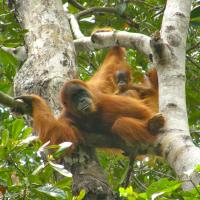
Sumatran orangutans have undergone a substantial recent population decline Sumatran orangutans have undergone a substantial recent population decline, according to a new genetic study, but the same research revealed the existence of critical corridors for dispersal migrations that, if protected, can help maintain genetic diversity and aid in the species' conservation.
One of two species of orangutans, the Sumatran orangutan is classified as "critically endangered" by the IUCN Red List. Once widespread on the island of Sumatra, only an estimated 6,600 individuals remain, restricted to small forest patches on the northern tip of the island. Recent large-scale deforestation is among the most significant factors bringing about the range collapse of the apes.
A recent study published via Advance Access (DOI: 10.1093/jhered/ess065) in the Journal of Heredity investigated population structure, movement patterns, and reproductive interchange in Sumatran orangutans using genetic techniques. The investigators isolated DNA from fecal and hair samples from wild apes throughout their Sumatran range, as well as blood samples from orangutans of known origin that had been kept privately as pets before being confiscated by authorities. The investigators used two different genetic markers to examine population structure and gene flow: mitochondrial DNA, which is inherited only from an individual's mother, and autosomal microsatellites, short, repeated DNA elements that are inherited from both parents.
A strong genetic signal revealed a striking population decline in Sumatran orangutans. "The orangutans from one of the study areas on the west coast of the island exhibited very high genetic diversity," explained Dr. Alexander Nater of the University of Zurich Anthropological Institute & Museum, lead author on the study. "This diversity is a clear indication of a large historical population size. However this area currently harbors only around 400 orangutans," leading the authors to conclude that the population has recently declined dramatically.
The data also showed that Sumatran orangutans have a pronounced population structure containing a number of subpopulations, resulting from geographical barriers including major rivers and a large volcanic caldera. These barriers isolate groups of orangutans, some of which contain only a few hundred individuals.
"Such isolated, small populations will inevitably suffer from a decline in genetic diversity and negative effects of inbreeding," said Nater. "This means that local orangutan populations are at substantial risk of extinction."
Extinction risk can be further exacerbated when the subpopulations adapt to specific local environmental factors such as food sources or disease. While these local adaptations may allow the subpopulation to thrive in the short run, if environmental conditions change quickly the group may be unable to adapt.
Despite the isolation of the subpopulations, the authors found genetic evidence for recent reproductive interchange, specifically by breeding males. "Our study revealed that some males can range widely over large distances and across natural barriers in search of females," Nater said.
The data pinpointed a specific inland high-elevation area as an important corridor for reproductive interchange across the island. The males appear to be using this passage to circumvent major rivers close to their headwaters high in the mountains, providing important genetic exchange among Sumatran populations.
But it is critical that these corridors remain forested to facilitate these migrations. Sumatran orangutans are the most arboreal of the great apes, spending nearly all of their time in the forest canopy.
"This result highlights the need to conserve these important dispersal corridors to uphold genetic exchange," Nater said, "and it also gives hope that it is not yet too late to preserve these unique Asian great apes." Source : American Genetic Association
 Print Article
Print Article Mail to a Friend
Mail to a Friend
